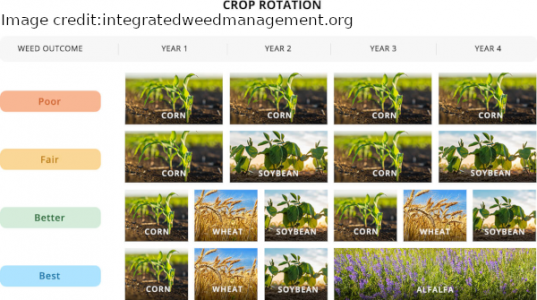Table of content
- What is crop rotation?
- What are the benefits of crop rotation?
- An example crop rotation schedule
- How to make your own crop rotation plan
What is crop rotation?
Crop rotation is when each year a different plant is grown in a spot, for example if a farmer were to grow wheat in a field one year and field peas and a field the next year.
What are benefits of crop rotation?
Rotating crops from one year to the next between different varieties increases yields by 10% to 25% by growing plant that require different amounts of nutrients and by interspersing them with legumes to add nitrogen. This allow those who use crop rotation to use less fertilizer in there large scale agriculture. Crop rotation also considerable reduces insect problems so those who use crop rotation can almost completely eliminating the need for pesticides in there large scale agriculture. Crop rotation also helps prevent diseases in plants. Another thing crop rotation does is it helps the soil structure which helps retain water. The use of crop rotation also helps control weed so that the cultivated plants get more of the nutrient in the soil. By rotating plants with different root structures crop rotation helps prevent erosion of fields and loss of soil so more of the nutrients stay in the fields.
An example crop rotation schedule
Year one: Potatoes
Year two: Field peas
Year three: Cabbage
Year four: Buckwheat then Turnips
How to make your own crop rotation plan
There are a couple of main rules to follow:
- Do not plant the same family in the same spot 2 years in a row(because insects, nematodes, and pathogens are all attracted to specific kinds of plants so by mixing up the families you plant in a spot it helps prevent infection from pests).
- Intersperse other kinds of plant with legumes(because legumes fix nitrogen into the soil).
- Do not grow the same kind of plant in the same spot 2 years in a row(for example a heavy grain yielding plant).
- Follow deep rooted plants with shallow rooted plants and vice versa.
- When growing high yielding plants that are suggestible to diseases alternate them with low yielding plants that are very resistant to diseases.
- Alternate high effort plants with low effort plant.
- Have a preferably 4 year cycle because many soil borne diseases stay in the soil for 3 years so even if the plants are not effected you can avoid the infection.
- It is good to have cover crops as part of your crop rotation because many of them build up the soil and some of them deter pests.
When it comes to actual making the plan I suggest that you:
- Choose the varieties you are going to rotate.
- Order the varieties based on there climate needs so that they grow at optimum times(such as growing a cold hardy plant early or late in the year when it is cool and growing a heat hardy plant in the hot part of the year).
- Make your rotation schedule.
For more detailed instructions on creating a crop rotation plan click here.
